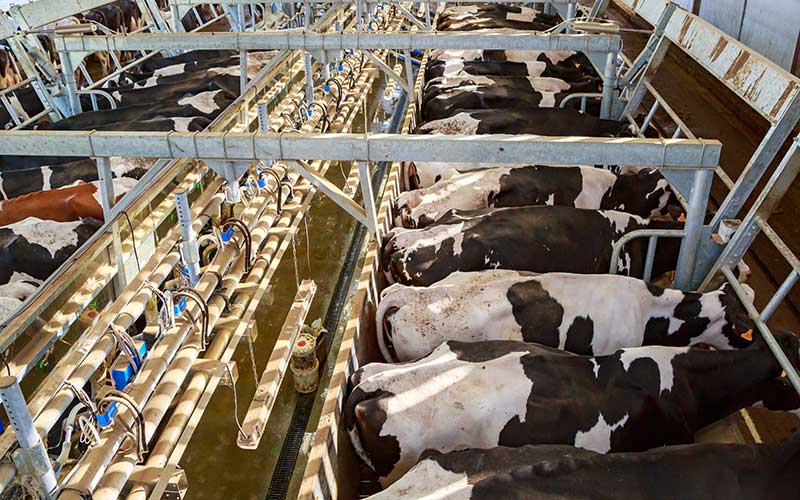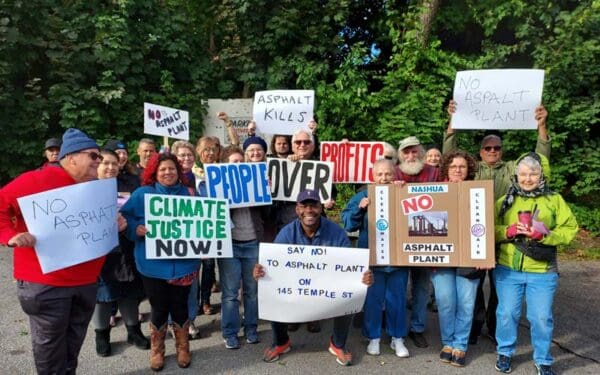
Factory farms that confine large numbers of cows in a small space produce dangerous methane emissions that damage our climate. Big Ag claims anaerobic digesters can solve this climate problem – but that's not the full story. Photo: Shutterstock
Big Agriculture knows it has a climate problem. Factory farms – industrialized facilities raising large numbers of animals for food – belch methane, a climate-damaging gas 27 times more potent than carbon dioxide. But instead of stopping methane at its source, industrial agriculture is trying to profit by producing more of it.
More and more industrial farms are installing anaerobic digesters, systems that use liquified livestock manure to manufacture “renewable” natural gas. Factory farms claim that these digesters are climate solutions. But “renewable” natural gas is actually methane. It isn’t renewable, and it won’t help cut climate-damaging emissions. Fossil fuel companies are using “renewable” natural gas to convince New Englanders to pay for more gas pipelines, and Big Agriculture uses it to greenwash factory farms.
Now, Novilla RNG wants to build an anaerobic digester on Pleasant Valley Farms, Vermont’s biggest dairy operation. The project involves building a 7.7-mile pipeline to connect the digester to Vermont Gas Systems’ statewide fossil gas distribution network. Vermont Gas plans to make families and businesses pay for part of the pipeline. Novilla RNG asserts that the project will help the farm avoid emissions associated with managing manure.
But this project isn’t the green solution that Novilla RNG claims it is. Here’s why CLF opposes this proposed project – and why it’s a bad idea for Vermonters.
Industrial Agriculture’s Methane Problem Is Bad, and It’s Only Getting Worse
Agriculture accounts for more climate-damaging methane emissions than any other source in the United States. More than natural gas and petroleum systems. More than coal mining. More than landfills.
Manure management on industrial meat, poultry, and dairy farms produces about 10% of this methane – and factory farms produce a lot of manure. One industrial farm’s sanitary waste can dwarf an entire city’s. In fact, every day, Pleasant Valley Farms’ 4,000 mature dairy cows produce as much raw waste as 188,880 people – four times Burlington, Vermont’s population.
How farms manage their manure matters for the climate. Some practices produce a lot of methane. Others produce very little. Unfortunately, industrial farms that confine animals in cramped quarters generally choose to liquify and store manure in massive pits known as “lagoons.” Manure in these lagoons decomposes in anaerobic conditions – without oxygen – which generates lots of methane. Also, lagoons sometimes fail, spilling millions of gallons of pollutants into nearby waters.
Dairy farms, like Pleasant Valley Farms, are some of the worst culprits when it comes to methane. Since 1990, methane emissions from manure management on American dairy farms have more than doubled per cow. That’s because dairy farms have increasingly relied on confinement farming and manure lagoons. No other agricultural subsector has incurred such a dramatic increase in climate-damaging methane emissions.
Anaerobic Digesters Maximize Methane Production and Lock Industrial Farms into Climate-damaging Systems
Given how damaging methane is to our climate, we should be taking steps to generate as little of it as possible on our farms.
But, anaerobic digesters do the opposite. They are designed to manufacture as much methane as possible. Once produced, the methane gets “upgraded” to “renewable” natural gas, mixed with fossil gas inside gas pipelines, and sold to customers for our homes and businesses. “Renewable” natural gas often leaks from those pipes along the way, harming the climate. And it endangers public health.
What’s more, anaerobic digesters cost millions of dollars to install – even with the help of subsidies. A factory farm must produce massive amounts of manure to justify that expense. That, in turn, locks us into the same climate-damaging, polluting system that creates Big Agriculture’s climate problem, threatens air quality in farm communities, and puts water quality at risk.
Climate Pollution From Farms Is a Bigger Problem than Manure – and Sustainable Ways to Deal with It Already Exist
Big Agriculture and the fossil fuel industry say that anaerobic digesters help farms fight the climate crisis by reducing methane emissions and replacing fossil gas. Novilla RNG even makes the misleading claim that mixing one part of their “renewable” natural gas can make three parts of fracked gas carbon neutral. That’s just greenwashing. Fracked gas is still a fossil fuel that contributes to the climate crisis.
Industrial farms don’t need anaerobic digesters to reduce their climate-damaging emissions. Instead, they could start by allowing farm animals to spend more time on pasture and shifting towards solid-based manure management.
And what’s worse: Anaerobic digesters address just a fraction of agriculture’s climate-damaging emissions. Soil management accounts for four times more emissions than manure management. Even cow burps produce more emissions.
But industrial farms can’t address these other sources of climate-damaging emissions if they’re tied to factory farming by million-dollar digesters. They must produce and concentrate manure to generate “renewable” natural gas. And to produce and concentrate manure, they need to factory farm.
New England Should Be Supporting Sustainable Farms, Not Investing in “Renewable” Natural Gas
Back in the 1970s, U.S. Secretary of Agriculture Earl Butz told farmers to “get big or get out.” Industrialize or step aside. But investments in industrial agriculture haven’t paid off. Instead, they’ve yielded pollution and climate-damaging emissions. “Renewable” natural gas from anaerobic digesters is just another boondoggle offered by Big Agriculture to maintain this harmful factory farming system.
Instead of investing in this false climate solution, we should be making investments that help small, sustainable farms provide healthy, affordable, local food to New Englanders. And we should be helping the region’s industrial farms chart a path away from factory farming.
Novilla RNG’s proposal to build an anaerobic digester on Pleasant Valley Farms will not accomplish that goal. This project would keep the state’s largest dairy farm shackled to unsustainable practices, and keep Vermont hooked on polluting fuels and dangerous infrastructure.
We can – and must – do better. Vermont regulators must reject this irresponsible proposal. And we must continue the fight to level the playing field so that New England’s sustainable farms can compete on fair terms with Big Agriculture.




